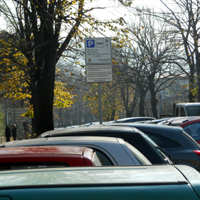
Un sistema di supporto alle decisioni per l’analisi dei conflitti derivanti dall’implementazione delle politiche di pricing
Abstract
Negli ultimi anni molte città europee hanno introdotto politiche di tariffazione come strumento di gestione della domanda di trasporto, in particolare per ridurre la congestione e riequilibrare la ripartizione modale tra trasporto individuale e collettivo. Infatti, il comportamento degli utenti conduce il sistema ad una condizione di Equilibrio dell’Utente (User Equilibrium) che non corrisponde alla massimizzazione dell’utilità globale e non prende in considerazione i costi esterni. Pertanto, al fine di raggiungere una configurazione efficiente nell’utilizzo dei sistemi di trasporto (indicata in letteratura come Equilibrio del Sistema – System Equilibrium), è necessario imporre una tariffazione sulle strade urbane in modo da massimizzare il surplus sociale. Per numerose ragioni (teoriche, politiche, sociali) è impossibile applicare “tariffe efficienti” (indicate in letteratura come first-best solutions); perciò sulle reti reali bisogna applicare tariffe sub-ottimali (second-best solutions). Inoltre, una delle problematiche principali dell’applicazione delle politiche di pricing è la loro “accettazione” da parte della comunità e/o di sue componenti (commercianti, residenti, pendolari, ecc.) che conduce a conflitti ed opposizioni.
In questa nota, si analizza il problema del progetto delle tariffe ottimali nel caso in cui i ricavi siano investiti totalmente o parzialmente per migliorare il trasporto collettivo. In particolare, si formula un modello che sia multimodale e multiutente, in cui gli aspetti relativi alla scelta modale siano calcolati in maniera esplicita su rete in corrispondenza di ciascuna configurazione tariffaria. Il modello è applicato ad una rete test (costruita con differenti valori di accessibilità relativa tra le differenti zone), analizzando alcune strategie “second-best” con particolare riferimento al reinvestimento dei ricavi.
Keyword
Full Text
PDFRiferimenti bibliografici
Agenzia Milanese Mobilità e Ambiente (2009) “Monitoraggio Ecopass: Gennaio–Dicembre 2008”.
Arnott R., Krauss M. (1998) “When are anonymous congestion charges consistent with marginal cost pricing?”, Journal of Public Economics 67, 45-64.
Beckmann M., Mcguire C.B., Winsten C.B. (1956) “Studies in the Economics of Transportation”, Yale University Press, New Haven (CT), USA.
Cantarella G.E. (1997) “A general fixed-point approach to multimodal multi-user equilibrium assignment with elastic demand”, Transportation Science 31, 107-128.
Cascetta E. (2009) “Transportation systems analysis: models and applications”, Springer, New York (NY), USA.
D’Acierno L., Gallo M., Montella B. (2006) “Optimisation models for the urban parking pricing problem”, Transport Policy 13, 34-48.
Ekström J., Engelson L., Rydergren C., 2009. “Heuristic algorithms for a second-best congestion pricing problem”. Netnomics 10, pp. 85-102.
Eliasson J., Hultkrantz L., Nerhagen L., Rosqvist L.S. (2009) “The Stockholm congestion-charging trial 2006: Overview of effects”, Transportation Research Part A 43, 240-250.
Farrel S., Salesh W. (2005) “Road-user charging and the modelling of revenue allocation”, Transport Policy 12, 431-442.
Ferrari P. (2005) “Road Pricing and users’ surplus”, Transport Policy 12, 477-487.
Gentile G., Papola N., Persia L. (2005) “Advanced pricing and rationing policies for large scale multimodal networks”, Transportation Research Part A 39, 612-631.
Ieromonachou P., Potter S., Warren J.P. (2007) “A strategic niche analysis of urban road pricing in the UK and Norway”, European Journal of Transport and Infrastructure Research 7, 15-38.
Hamdouch Y., Florian M., Hearn D.W., Lawphongpanich S. (2007) “Congestion pricing for multi-modal transportation systems”. Transportation Research Part B 41, 275-291.
Huang H.J. (2002) “Pricing and logit-based mode choice models of a transit and highway system with elastic demand”, European Journal of Operational Research 140, 562-570.
Kottenhoff K., Brundell Freij K. (2009) “The role of public transport for feasibility and acceptability of congestion charging-The case of Stockholm”, Transportation Research 43, 297-305.
Kuwahara M. (2007) “A theory and implications on dynamic marginal cost”, Transportation Research Part A 41, 627-643.
Lawphongpanich S., Hearn D.W. (2004) “An MPEC approach to second-best toll pricing”, Mathematical Programming 101, 33-35.
Odeck J., Bråthen S., 2008. “Travel demand elasticities and users attitudes: A case study of Norwegian toll projects”. Transportation Research A, 42 pp. 77-94.
Pigou A.C. (1920) “The economics of welfare”, MacMillan, London, United Kingdom.
Prud’homme R., Bocarejo J.P. (2005) “The London congestion charge: a tentative economic appraisal”, Transport Policy 12, 279-287.
Rouwendal J., Veroef E.T. (2006) “Basic economic principles of road pricing: From theory to applications”, Transport Policy 13, 106-114.
Stewart K. (2007) “Tolling traffic links under stochastic assignment: Modelling the relationship between the number and price level of tolled links and optimal traffic flows”, Transportation Research Part A 41, 644-654.
Transport for London (2008) “Central London Congestion Charging: Impacts Monitoring”, 6th Annual Report, Transport for London, London, United Kingdom.
Verhoef E.T., Nijkamp P., Rietveld P. (1996) “Second-best congestion pricing: the case of an untolled alternative”, Journal of Urban Economics 40, 279-302.
Verhoef E.T. (2002) “Second best congestion pricing in a general networks: heuristic algorithms for finding second-best optimal toll levels and toll points”. Transportation Research Part B 36, 707-729.
Yang H., Huang H.J. (2004) “The multi-class, multi-criteria traffic network equilibrium and system optimum problem”, Transportation Research Part B 38, 1-15.
Yang H., Zhang X. (2008) “Existence of anonymous link tolls for system optimum on networks with mixed equilibrium behaviours”, Transportation Research Part B 42, 99-112.
Yildirim M.B., Hearn D.W. (2005) “A first best toll pricing framework for variable demand traffic assignment problems”, Transportation Research Part B 39, 659-678.
Zhang H., Ge Y.E. (2004) “Modeling variable demand equilibrium under second-best road pricing”, Transportation Research Part B 38, 733-749.
DOI: http://dx.doi.org/10.6092%2F1970-9870%2F603
Refback
- Non ci sono refbacks, per ora.

This work is licensed under a Creative Commons Attribution 3.0 License.



